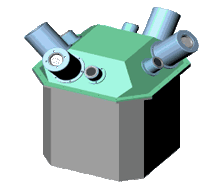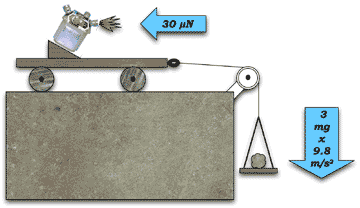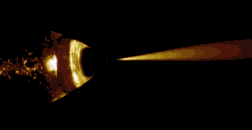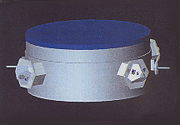 |
The DRS uses clusters of
micronewton thrusters.
|
The Space Technology 7 Disturbance Reduction System (DRS) requires thrusters that are capable of varying thrust. They must smoothly and continuously counter all external disturbances, primarily solar pressure, with control authority over all six degrees of freedom (to move in all directions) of the spacecraft motion. DRS uses micronewton thrusters——a newly improved technology that has high-stability dual electrode thrusters, a high-stability propellant feed system, nanotube field emission, and high voltage converters.
 |
|
The maximum thrust produced by the colloid micronewton thrusters is equal to the weight of a 3-mg grain of sand!
|
A newton is a unit of force, equal to the weight of about 100 grams
(about four ounces). The thrusters produce a force of about 30
micronewton. Using these thrusters while DRS is in operation will enable scientists to measure a force change on the test masses of about one femtonewton, where femto equals 10-15, during a ten minute measuring session.
 |
A stream of charged droplets.
|
 |
Example of micronewton thrusters attached to a simple spacecraft.
|
The DRS micronewton thrusters consist of miniature ion engines. They are propelled by colloidal fluid that is fed through a needle by a pressurizing system. At the tip of the needle, a high electrical field is applied. This causes droplets to form and to be ejected from the tip of the needle. The droplets are spontaneously ionized and accelerated by high voltage, to generate variable thrust in the desired range.
Precise changes in thrust can be achieved by changes to the accelerating voltage. A cathode is included to emit electrons, which keeps the spacecraft neutral. This prevents the spacecraft from becoming negatively charged by the continual ejection of positively-charged droplets.
Eight colloidal thrusters are mounted in clusters at two points on the host spacecraft's perimeter. The thrusters generate enough thrust to control the spacecraft in the required six degrees of freedom. They will counteract both external and internal pressures on the test masses. For example, the strongest external force on the ST7 spacecraft will be from sunlight, which will be equal to one-hundredth the weight of a postage stamp. The thrusters have just enough thrust to push back against the Sun's pressure. This will balance the force of the Sun almost perfectly, leaving a residual that is 10,000 times smaller still.
One undesired internal pressure will be gravity from the spacecraft itself. Sensitive instruments on Earth are ordinarily constructed to directly register gravity, an inherently weak force, generated by any object other than the Earth itself. Weighing about one ton, the spacecraft is capable of exerting force on the test masses far in excess of the minimum level that instruments are required to measure. This minimum level is enough to give it the weight of a flea!
This new type of miniature ion-engine microthruster, along with the DRS instrument technologies, will provide alternative approaches to position control of future separated-spacecraft missions.